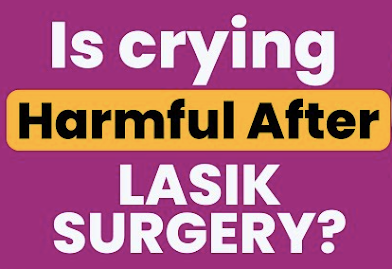Why can't I Cry after Lasik?
Introduction:
The common refractive surgery method known as LASIK, or laser-assisted in situ keratomileusis, treats nearsightedness, farsightedness, and astigmatism. Even though LASIK has helped numerous people gain clear vision, some patients frequently notice alterations in their tear production after the treatment. These modifications may cause a reduction in the capacity to cry and, in rare instances, the incapacity to cry. This article examines the causes of this issue and offers suggestions for those who find it difficult to cry after LASIK.
The implications of Lasik surgery should be understood:
Lasik surgery is a well-liked and reliable option to treat nearsightedness, farsightedness, and astigmatism. It is a refractive surgery in which the cornea, the transparent front surface of the eye, is reshaped using lasers to enhance the focus of light on the retina.
It's critical to comprehend the dangers and probable side effects of Lasik surgery before deciding whether to get the treatment. Lasik has a high success rate, with most patients seeing significantly better vision, but certain possible side effects and issues might happen.
Dry eyes are one of the most typical adverse effects. It is typical for individuals to feel pain and dryness in their eyes just after surgery. These symptoms could last longer for some people, though. Glare, halos, and difficulties seeing at night are other potential adverse effects that might impair one's ability to drive or complete various jobs in low light. Patients could occasionally develop more severe side effects, including infection, ocular blurring, or vision loss.
Factors that might prevent the formation of tears after lasik:
After having LASIK surgery, several things may limit tear formation. It is crucial to comprehend these aspects to properly care for and assist patients who could develop dry eye symptoms after surgery.
First off, age has a big impact on how many tears are produced. Tear production typically declines with age; this decline may become much more pronounced following LASIK. The eye's condition and surrounding tissues may also influence tear production. Patients with autoimmune illnesses, meibomian gland dysfunction, or dry eye syndrome may be more likely to experience post-LASIK reduced tear production.
Additionally, the LASIK surgical procedure itself may have an impact on tear generation. The nerve fibers that direct the production of tears can be damaged by creating a corneal flap and then reshaping the cornea. Sometimes it might take these nerves months or even years to repair fully, leading to a temporary or persistent reduction in tear production.
Environmental aspects must also be taken into account. Post-LASIK, tear production may be reduced due to prolonged exposure to air conditioning or heating systems, dry or dusty settings, or both. Patients should be counseled to use suitable precautions, such as artificial tears or protective eyewear.
The usage of medicine may also affect tear production. Antihistamines and certain antidepressants, for example, can dry up the ocular surface and impair tear formation in LASIK patients.
A variety of causes might hamper the generation of tears following LASIK. Managing the symptoms of dry eyes and ensuring the best post-operative patient outcomes may be accomplished by being aware of these issues and offering the necessary care and support. Before surgery, patients must be properly evaluated, informed of any dangers or potential consequences, and given measures to encourage tear production and ocular surface health.
Why is it challenging to cry after having Lasik surgery?
A common technique that corrects vision issues and does away with the need for glasses or contact lenses is lasik surgery. Dry eyes, which make it difficult to produce tears, are a typical side effect that some Lasik surgery patients have.
A tiny flap is made in the cornea and molded to correct eyesight during the Lasik operation. The ocular nerves responsible for producing tears are momentarily damaged during this procedure. Due to dry eyes and difficulty sobbing, many patients may suffer reduced tear production.
It is crucial to remember that dryness and decreased tear production following Lasik surgery are often transient and progressively improve over time as the corneal nerves recover. Within a few weeks or months following the surgery, most individuals' capacity to cry returns to normal.
You may take several actions in the meantime to lessen the discomfort brought on by dry eyes and promote tear production. Your ophthalmologist may advise lubricating eye drops or artificial tears to moisten the eyes. In addition, maintaining excellent eye hygiene by limiting screen time and taking regular breaks will help lessen dryness and pressure on the eyes.
It is crucial to speak with your eye doctor or healthcare provider if, following Lasik surgery, you continue to have persistent or severe dry eyes. Based on your unique situation, they can provide ideas and personalized advice.
Remember that while dry eyes and trouble weeping after Lasik surgery might be alarming, they are frequently transient and go away with the right attention and time. You may manage this little annoyance and profit from better eyesight in the long run with persistence and expert coaching.
Strategies to use if you experience dry eyes after LASIK include:
LASIK surgery frequently results in dry eyes, but there are ways to reduce this pain. Maintaining lubrication and eye protection after LASIK surgery is crucial to promoting healing and reducing dryness.
Artificial tears are one of the best methods for treating dry eyes after LASIK. These lubricating eye drops can replace natural tears that may momentarily be less plentiful after surgery. Artificial tears without preservatives are advised since some preservatives might irritate. Your eyes will stay comfy and moisturized using the drops your eye doctor recommends.
Avoiding activities that can make you feel dry is another useful tactic. It could involve spending much time in dry places and in front of screens. Use a humidifier in your home or workplace to keep the air moist and avoid dryness, and take frequent pauses to rest your eyes.
To treat dry eyes after LASIK, your eye doctor may occasionally advise using prescription drugs or ointments. These can include drugs that increase tear production or lubricating ointments that last longer. Your doctor will choose the best course of action based on the degree of your dryness and any underlying conditions.
It's crucial to adhere to all post-operative advice your eye doctor gives. To prevent unintentional injury to the eyes, this may entail refraining from rubbing or touching them, putting on safety eyewear when outside, and utilizing eye shields. At the same time, you sleep to speed up your recovery and reduce dryness.




Comments
Post a Comment